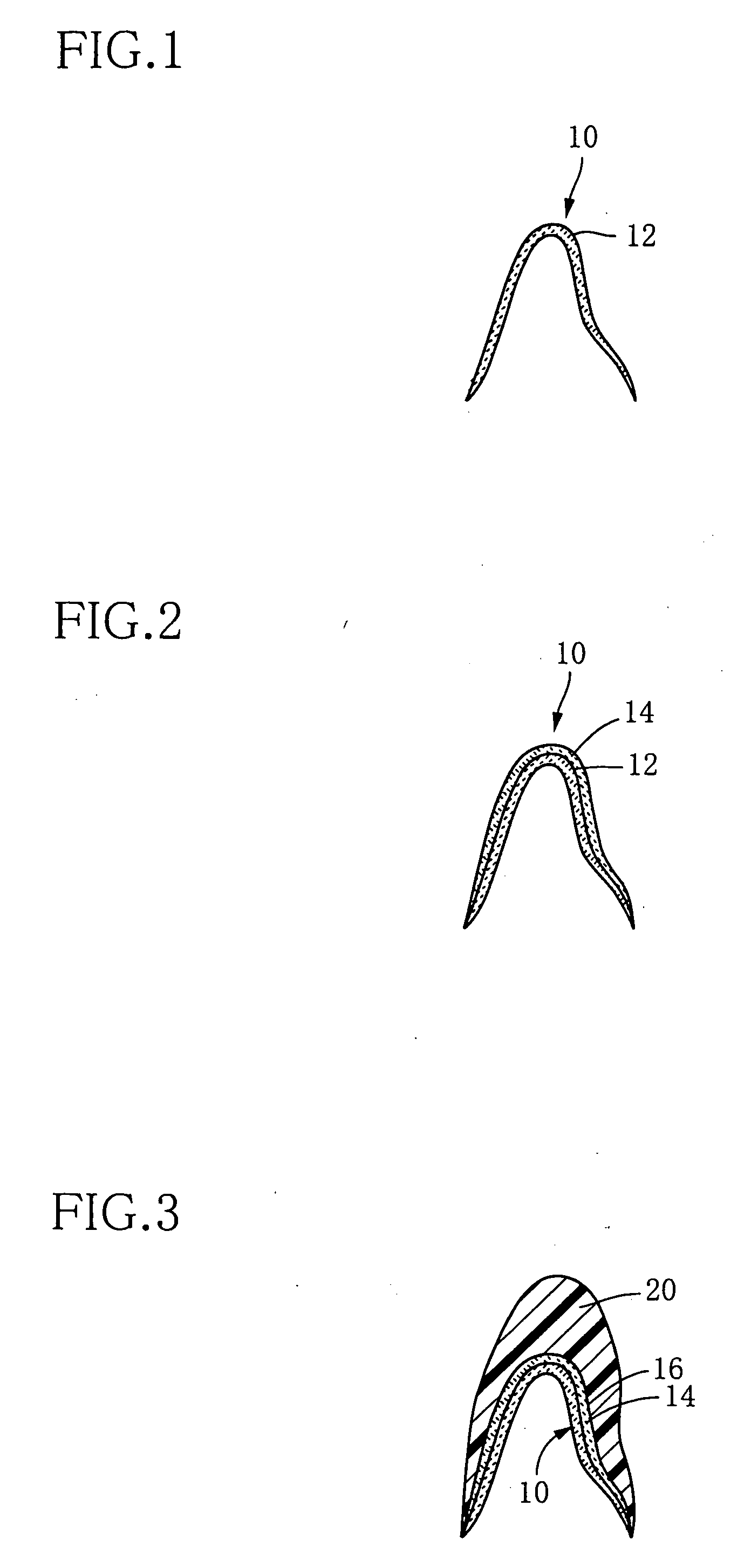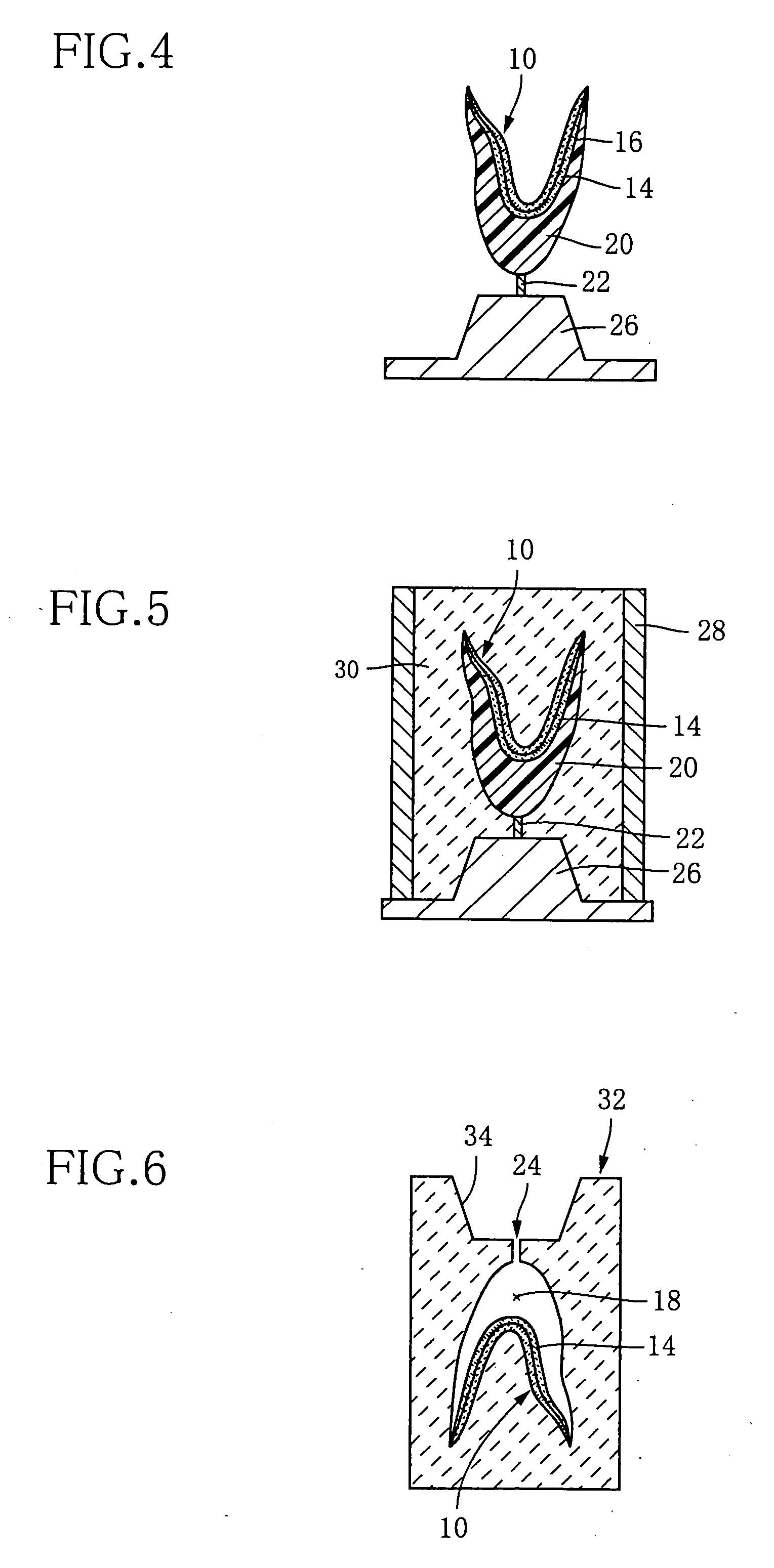Process for producing dental prosthesis and kit for use for therein
a technology for which is applied in the field of manufacturing dental prostheses and kits, can solve the problems of limited use of single crowns, no mechanical strength and tenacity of alumina nor spinel, etc., and achieve excellent beauty, high fluidity, and excellent beauty.
- Summary
- Abstract
- Description
- Claims
- Application Information
AI Technical Summary
Benefits of technology
Problems solved by technology
Method used
Image
Examples
example 1
[0131]FIGS. 1-7 are schematic views for explaining a method of manufacturing a dental crown 38 as an example of a dental prosthesis according to an example of the first and second inventions. The crown 38 is to be mounted, for example, as a front tooth of an upper jaw of an adult. The present invention is applicable also to all other teeth. In FIG. 1, the frame 10 made of zirconia (single crown frame) produced separately is prepared. This frame 10 made of zirconia is produced by conventionally known means, for example, forming a denture mold with plaster and pouring the zirconia into the denture mold.
[0132] First, a first porcelain was uniformly applied (mounted) with a brush, onto a surface 12 of the above-described frame 10 made of the zirconia, such that the first porcelain had a thickness of about 0.1 (mm). The first porcelain used herein is slurry including ceramic powders of composition indicated in Table 1 given below and prepared by mixing 100 mass parts of propyleneglycol-...
examples 2-10
[0142] In each of these examples, a dental crown having the same configuration as Example 1 was manufactured in the same manner as in Example 1, except that the second porcelain in the form of ceramic powders having composition indicated in Table 2 was used and that viscosity of the second porcelain at the casting temperature was as indicated in Table 2. It is noted that “VISCOSITY” in Table 2 indicates a value at the casting temperature.
TABLE 2VISCOSITYNo.SiO2Al2O3K2ONa2OLi2OB2O3CaOCeO2MgOSb2O3ZrO2(cP)264.315.89.95.90.30.11.00.71.01.0—4.5 × 106362.617.89.74.90.31.01.00.71.01.0—5.0 × 106463.915.89.94.90.31.01.00.71.01.00.55.3 × 106564.716.010.05.00.31.01.0—1.01.0—5.4 × 106664.316.210.64.80.20.81.20.80.11.0—6.3 × 106765.415.210.54.80.40.81.00.80.11.0—6.4 × 106866.716.09.04.50.31.01.5—1.01.0—7.2 × 106966.015.910.04.50.10.80.70.80.21.0—7.5 × 1061066.616.49.24.10.10.80.50.80.51.0—8.5 × 106
(Indicating composition of second porcelain used in each Example: (mass %))
[0143] As is apparent...
example 11
[0145] In this Example, a frame made of a metal was used as the substrate. The metal frame is constituted by 78 (mass %) of Au, 7.1 (mass %) of Pt, 9.8 (mass %) of Pd, 2.4 (mass %) of Ag and inevitable impurity.
[0146] Further, in this Example, a back coating layer was formed in the same manner as in Example 1, except that the first porcelain used herein included ceramic powders of composition indicated in Table 3 in place of the composition indicated in Table 1 and that a burning temperature of the back coating layer was 980 (° C.).
TABLE 3FIRSTSECONDPORCELAINPORCELAINMATERIALSiO247.764.5COMPOSITIONAl2O314.014.3(Mass %)K2O10.010.0Na2O6.09.0Li2O0.30.3ZrO2—0.5CaO1.01.0MgO1.00.4SnO220.0—VISCOSITY1.5 × 107 (cP)1 × 107 (cP)AT CASTINGTEMPERATURE
[0147] Subsequently, a cast coating layer was formed in the same manner as in Example 1, except that the second porcelain used herein included ceramic powders of composition indicated in Table 3 in place of the ceramic powders of the composition ...
PUM
| Property | Measurement | Unit |
|---|---|---|
| Temperature | aaaaa | aaaaa |
| Percent by mass | aaaaa | aaaaa |
| Percent by mass | aaaaa | aaaaa |
Abstract
Description
Claims
Application Information
 Login to View More
Login to View More - R&D
- Intellectual Property
- Life Sciences
- Materials
- Tech Scout
- Unparalleled Data Quality
- Higher Quality Content
- 60% Fewer Hallucinations
Browse by: Latest US Patents, China's latest patents, Technical Efficacy Thesaurus, Application Domain, Technology Topic, Popular Technical Reports.
© 2025 PatSnap. All rights reserved.Legal|Privacy policy|Modern Slavery Act Transparency Statement|Sitemap|About US| Contact US: help@patsnap.com



